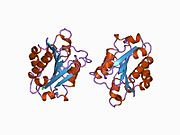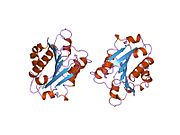Integrin alpha M
Ensembl | |||||||||
|---|---|---|---|---|---|---|---|---|---|
| UniProt | |||||||||
| RefSeq (mRNA) | |||||||||
| RefSeq (protein) |
| ||||||||
| Location (UCSC) | Chr 16: 31.26 – 31.33 Mb | Chr 7: 127.66 – 127.72 Mb | |||||||
| PubMed search | [3] | [4] | |||||||
| View/Edit Human | View/Edit Mouse |
Integrin alpha M (ITGAM) is one protein subunit that forms
αMβ2 is expressed on the surface of many
In genomewide association studies, single nucleotide polymorphisms in ITGAM had the strongest association with
In
Function of CD11b
CD11b, as an integrin molecule on the surface of leukocytes, plays an important role in cell migration, adhesion, and transmigration across blood vessels, because it can bind to components of extracellular matrix and intracellular adhesion molecules (ICAMs) on the endothelial surface. This process is important for leukocyte recruitment into the site of inflammation.[7]
Moreover, there are other important processes with CD11b involvement, more precisely Mac-1 integrin involvement as a whole. One of which is phagocytosis of opsonised particles by a complement component iC3b. Such opsonised particles could be bacteria, apoptotic cells, and even immune complexes. CD11b binding to iC3b leads to a production of anti-inflammatory cytokines, e.g., interleukin 10 (IL-10) and tumour growth factor beta (TGFβ). This process is important for regulation of the inflammatory milieu.[7][11]
CD11b is also involved in the differentiation of osteoclasts, bone remodelling cells. Mac-1 is expressed in osteoclast progenitors, and it seems that it is a part of a negative feedback of osteoclastogenesis.[11] CD11b also modulates other functions of leukocytes, e.g. oxidative burst, apoptosis, binding of fibrinogen etc.[12]
On circulating
Therapeutic significance of CD11b
Regarding CD11b function, it is apparent that it plays an important role in immune cell regulation. Once this regulation is disrupted, it may lead to a higher susceptibility to inflammatory and autoimmune diseases. Some examples would be systemic lupus erythematosus (SLE), lupus nephritis and certain types of cancer.[12][14]
Systemic Lupus Erythematosus
Genome Wide Association Studies helped to uncover 3 main single nucleotide polymorphisms (SNPs) in CD11b, that are associated with the risk of developing SLE, cardiovascular disease, and lupus nephritis (a complication usually occurring along with SLE). These SNPs are: rs1143679 (R77H), rs1143678 (P1146S), and rs1143683 (A858V) and they result in the lower ability of CD11b to properly bind ICAM-1 and iC3b, thus decreased cell adhesion and phagocytosis. Reduced ability to negatively regulate the production of pro-inflammatory cytokines IL-6, IL-1β, and tumour necrosis factor α (TNFα) after TLR stimulation have been also observed in these mutations.[12]
CD11b plays a protective role during SLE and lupus nephritis owing to its anti-inflammatory properties. Lupus nephritis is characterised by the accumulation of immune complexes in kidneys and overall immune infiltration into kidneys, which results in renal damage. This debilitating complication of SLE is associated with the above-mentioned mutations in CD11b. Patients with ITGAM SNPs have higher serum levels of interferon type I (IFN-I), which is one of the risk factors for developing SLE and lupus nephritis. Moreover, higher levels of other pro-inflammatory cytokines IL-6, IL-1β and TNFα after TLR stimulation, observed in patients with ITGAM SNPs, further drive the inflammation during this disease causing more tissue damage and creation of immune complexes.[7][12]
Hence, CD11b represents a possible therapeutic target for the treatment of SLE. Indeed, many attempts to target CD11b have been made. Firstly, antibody-based therapy which proved to be ineffective in the case of CD11b.[15] However, other therapies using small allosteric CD11b agonists seem to be a promising tool as their activation of CD11b leads to a regulation of TLR-dependant pro-inflammatory pathways and protection from renal damage.[12]
Tumours
CD11b seems to be a potent player in managing certain types of
Using CD11b agonists seems to be of importance in
See also
References
- ^ a b c GRCh38: Ensembl release 89: ENSG00000169896 – Ensembl, May 2017
- ^ a b c GRCm38: Ensembl release 89: ENSMUSG00000030786 – Ensembl, May 2017
- ^ "Human PubMed Reference:". National Center for Biotechnology Information, U.S. National Library of Medicine.
- ^ "Mouse PubMed Reference:". National Center for Biotechnology Information, U.S. National Library of Medicine.
- ^ PMID 15485828.
- S2CID 36709941.
- ^ PMID 29600248.
- PMID 6874946.
- PMID 18204099.
- PMID 18204098.
- ^ PMID 32092981.
- ^ PMID 35288363.
- PMID 32164908.
- ^ PMID 34452928.
- PMID 33294123.
Further reading
- Stewart M, Thiel M, Hogg N (October 1995). "Leukocyte integrins". Current Opinion in Cell Biology. 7 (5): 690–696. PMID 8573344.
- Todd RF, Petty HR (May 1997). "Beta 2 (CD11/CD18) integrins can serve as signaling partners for other leukocyte receptors". The Journal of Laboratory and Clinical Medicine. 129 (5): 492–498. PMID 9142045.
- Schymeinsky J, Mócsai A, Walzog B (August 2007). "Neutrophil activation via beta2 integrins (CD11/CD18): molecular mechanisms and clinical implications". Thrombosis and Haemostasis. 98 (2): 262–273. S2CID 41094726.
External links
- Integrin+alphaM at the U.S. National Library of Medicine Medical Subject Headings (MeSH)
- Mouse CD Antigen Chart
- Human CD Antigen Chart
- ITGAM Info with links in the Cell Migration Gateway Archived 2014-12-11 at the Wayback Machine









